Search results for: 'form'
-
 Paar antiker Goldohrringe aus römischer Kaiserzeit
Paar antiker Goldohrringe aus römischer KaiserzeitSehr gut erhaltene, aufwendig produzierte Schmuckstücke. Gold, kunstvoller, hohl gefertigter Körper mit massivem Bügel.
Price: on request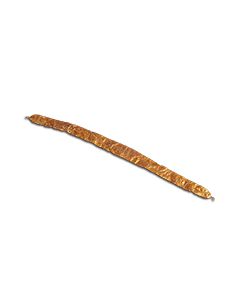 Mycenaean gold diadem
Mycenaean gold diademDelicate piece of ancient jewelry made of gold foil
Price: on request Roman glass beaker
Roman glass beakerThis beaker type was popular in the Holy Land during the time of Jesus Christ. But products of the local workshops were also exported.
Price: on request Late Roman glass flask
Late Roman glass flaskFlat bottle with double handle from the Eastern Mediterranean. Made between the 3rd and 6th century.
Price: on request Egyptian amulet of Bes
Egyptian amulet of BesProtective amulet with dwarf god Bes. A typical specimen for its kind from Ancient Egypt.
Price: on request Schmales Dicknackenbeil der Trichterbecherkultur
Schmales Dicknackenbeil der TrichterbecherkulturDer kleine und elegante Beilkopf beeindruckt durch seine gute Erhaltung und ausgewogenen Proportionen. In diesem Zustand absolut museumswürdig! Ganggrabzeit bis Dolchzeit.
Price: on request Kleines Trapezbeil der Trichterbecherkultur
Kleines Trapezbeil der TrichterbecherkulturKlinge eines kleinen Beils mit dünnem Nacken aus schönem grauen Flint. Vermutlich für feine Arbeiten eingesetzt, z.B. zum Häuten. Dolmenzeit bis Ganggrabzeit.
Price: on request Interessanter Beilkopf aus dem späten Neolithikum
Interessanter Beilkopf aus dem späten NeolithikumBemerkenswert ist die grobe Bearbeitung ohne Politur, möglicherweise handelt es sich um ein unfertiges Werkstück. Etwa 2800 bis 2300 v. Chr.
Price: on request Dicknackenbeil aus dem Neolithikum
Dicknackenbeil aus dem NeolithikumKlinge eines dünnblattigen Dicknackenbeils. Trapezförmiger Körper mit schön polierten Breitseiten. Ganggrabzeit bis Dolchzeit.
Price: on request Münze zu 8 Reales - "Piece of eight", auch bekannt als "Piratengeld"
Münze zu 8 Reales - "Piece of eight", auch bekannt als "Piratengeld"Mexiko Stadt, Philipp III, um 1610 n. Chr. Außergewöhnlich gute Erhaltung. Unsterblich gemacht in Stevensons Meisterwerk "Die Schatzinsel".
Price: on request Egyptian pataikos
Egyptian pataikosGod or god-like dwarf. The figurine was supposed to have a magical protective function. 26th to 30th dynasty of Ancient Egypt. From a British private museum.
Price: on request Egyptian faience figurine of the dwarf god pataikos
Egyptian faience figurine of the dwarf god pataikosThe figurine was supposed to have a magical protective function. 26th to 30th dynasty of Ancient Egypt. From a British private museum.
Price: on request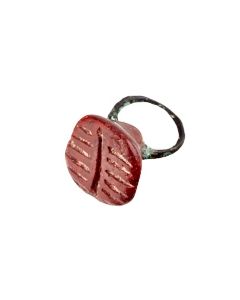 Anatolian porphyry stamp seal
Anatolian porphyry stamp sealBasic shape of a four sided pyramid. Made of wonderful intensely red stone. Middle Bronze Age of Anatolia.
Price: on request Mesopotamian stamp seal in bull shape
Mesopotamian stamp seal in bull shapeThe magnificent seal is from the Jemdet Nasr period. The stamp shows quadrupeds and a scorpion. Published in a book about the Epstein collection.
Price: on request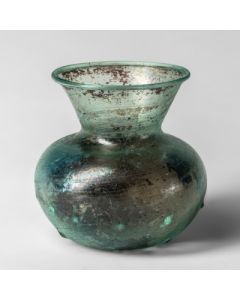 Roman glass vessel with knobs
Roman glass vessel with knobsA rare and impressive vessel type from a late Roman glass factory in the Levant. Dating from the 3rd to 4th century.
€1,080 Published cypriot milk bowl
Published cypriot milk bowl1977 on exhibition in the Bielefeld Museum of Fine Arts. Nicely preserved piece, from an old German private collection, acquired prior to 1972. Coming with an ArtLoss certificate.
Price: on request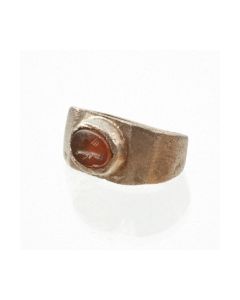 Roman silver wedding ring with intaglio showing dextrarum iunctio
Roman silver wedding ring with intaglio showing dextrarum iunctioSchönes Intaglio aus durchscheinend-rotem Karneol. Es zeigt die dextrarum iunctio, welche symbolisch für Verlobung oder Hochzeit steht. 16mm x 10mm Innenmaße. 3. Jh. n. Chr.
Price: on request Neolithic thick butted axe head
Neolithic thick butted axe headKlinge eines dünnblattigen Dicknackenbeils. Trapezförmiger Körper aus schönem grauen Flint mit kleinen Einschlüssen. Ganggrabzeit bis Dolchzeit.
Price: on request Spitznackiges Beil der Älteren Trichterbecherkultur
Spitznackiges Beil der Älteren TrichterbecherkulturSpitzovales Längsprofil, grob bearbeitete Seiten, teilweise poliert. Typische für die Ältere Trichterbecherkultur, 4200 bis 3300 v. Chr.
Price: on request Trapezförmiger Beilkopf der Trichterbecherkultur
Trapezförmiger Beilkopf der TrichterbecherkulturFein polierte Breitseiten, unpolierte Schmalseiten. Schöner Flint mit heller Steinader an der Schneide. Gefunden um 1900 in Schackendorf, Schleswig-Holstein.
Price: on request Gladiatorenlampe aus der römischen Kaiserzeit - Fund aus Deutschland
Gladiatorenlampe aus der römischen Kaiserzeit - Fund aus DeutschlandMuseales Stück. Erhabenes Spiegeldekor mit feinen Details, tiefer, gut lesbarer Stempel. Fund aus Region der Limeskastelle Pförring, Eining, Pfünz, Kösching und Weißenburg.
Price: on request Gorgeous Roman Imperial fibula
Gorgeous Roman Imperial fibulaThe large bow is dominated by colourful enamel. It is a brooch type that developed during the 1st cent. AD in Central Europe.
Price: on request Mycenaean seal with griffin
Mycenaean seal with griffinA wonderful and rare example of the Bronze Age Greek art of engraving stones. It shows a fantasy creature with lion body and bird of prey head. Mid-2nd Millennium BC.
Price: on request Egyptian amulet of Bes
Egyptian amulet of BesProtective amulet of the dwarf god Bes made of turquoise faience. Great specimen from Ptolemaic or Roman Egypt.
Price: on request Gallo-Roman animal fibula
Gallo-Roman animal fibulaZoomorphe Fibel mit Wildtier als Motiv. Schmuckstück mit religiöser Symbolik, vergleichbar einem Kreuzanhänger bei heutigen Christen. Gefertigt im 1. bis 3. Jh. n. Chr. in Gallien.
Price: on request Early Etruscan sanguisuga fibula
Early Etruscan sanguisuga fibulaThe early Etruscan bronze brooch is characterized by its artistically decorated bow. From the collection of Professor Alder-Kissling.
Price: on request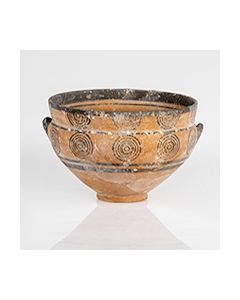 Large cypriot bowl, ex Sotheby's
Large cypriot bowl, ex Sotheby'sDating to the early cypro-archaic period, so-called black-on-red ware II. From an old German private collection, acquired 1970 at Sotheby's. Coming with an ArtLoss certificate.
Price: on request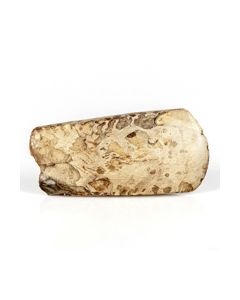 Neolithic thin butted axe head
Neolithic thin butted axe headAxe from the Early Neolithic is made of beautiful reddish brown flint with inclusions. Found in Northern Germany.
Price: on request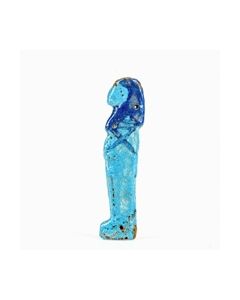 Appliqué of the Horus Son Imsety
Appliqué of the Horus Son ImsetyWonderful bichrome faience from the 30th dynasty or slightly later. Deaccessioned from an old museum lending collection.
Price: on request Neo-Assyrian cylinder seal with preserved bronze setting
Neo-Assyrian cylinder seal with preserved bronze settingFantastic and rare example for a cylinder seal in its original setting. From the reign of Tiglath-Pileser III in the 8th cent. BC.
Price: on request Canopic jar of Imsety
Canopic jar of ImsetyEgyptian Late Period canopic jar with a lid in the shape of a human head, representing the Horus son Imsety. The piece stands out by the expressive face and by the original painting.
Price: on request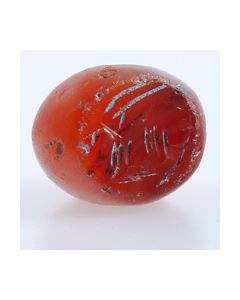 Sassanidisches Stempelsiegel mit springender Antilope
Sassanidisches Stempelsiegel mit springender AntilopeDunkler orangefarbener Karneol, der Stempel zeigt eine stilisierte springende Antilope. Hervorragender Zustand. Inklusive Stempelabdruck.
Price: on request Bronze statuette of Osiris
Bronze statuette of OsirisThe figurine is in exceptional condition with a nice patina. Late Dynastic period of Ancient Egypt, 664 to 332 BC.
Price: on request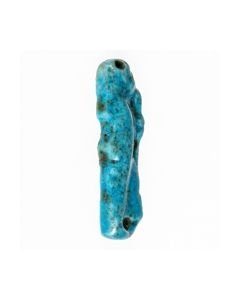 Appliqué of the Horus Son Imsety
Appliqué of the Horus Son ImsetyBeautiful turquoise fayence from the Late Period of Ancient Egypt. From the Toledo Museum of Arts collection, acquired in 1924 from the famous antiquities dealer R. H. Blanchard.
Price: on request Appliqué of the Horus Son Imsety
Appliqué of the Horus Son ImsetyRare variety with wooden core and gilded linen. Protective god responsible for the liver of a deceased. From the family of Lawrence of Arabia.
Price: on request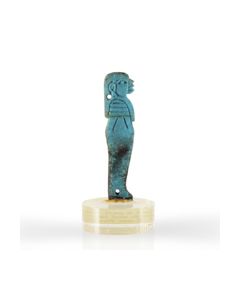 Appliqué of the Horus Son Imsety from Faiyum
Appliqué of the Horus Son Imsety from FaiyumMade of nice turquoise faience. Protective god responsible for the liver of a deceased. From the family of Lawrence of Arabia.
Price: on request

